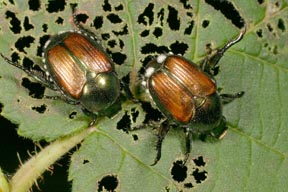Japanese Beetle | |
|---|---|
| May 6, 2008 | |
|
Application of imidacloprid (Merit and other brand names) and other systemic insecticides is effective in controlling Japanese beetle adults. Although the imidacloprid occasionally doesn’t work in a tree to control this pest, it does over 80 percent of the time. However, a soil application of imidacloprid takes up to 2 months to move completely up to the leaves of large trees. With Japanese beetle emergence typically ranging from the third week of June in southern Illinois, to the fourth week of June in central Illinois, and the end of June in northern Illinois, time is quickly passing to achieve control in that manner.  Imidacloprid can be soil-applied either as a drench or by injection. Because imidacloprid is easily tied up on organic matter, mulch and other dead organic matter must be removed from around the base of the tree before a drench application is made. Removal of turf around the tree would also be required for a drench. Soil injections should be made deep enough to get below mulch, turf thatch, and other organic matter, but not deeper than 3 to 4 inches. Apply to the soil within 1 to 2 feet of the trunk, where the greatest concentration of fine feeder roots is located. Northern Illinois had very high numbers of Japanese beetle adults last year, whereas many areas of central Illinois had very low numbers of the beetles for no obvious reason. Southern Illinois has rather typical numbers of the beetles. Last fall and winter was close to ideal for the survival of Japanese beetle grubs in the soil, so high numbers of beetles are expected this summer. Less than 11 inches of rainfall from July through fall reduces the survival of Japanese beetle larvae, and most areas of Illinois received this much rain. Irrigated turf will have made up for any deficiencies that may have occurred. Although the winter seemed to be severe to us, there were no extended periods of subzero temperatures to reduce insect numbers. Increased snowfall insulated Japanese beetle grubs from experiencing any long-term, deep-frozen soils, which can reduce their numbers. In addition, there were no winter thaws or early spring warm weather to possibly fool the grubs into burrowing close to the soil surface too early. The winter and spring conditions were almost ideal for most other overwintering insects in Illinois this year. | |
| Author: | Phil Nixon |
